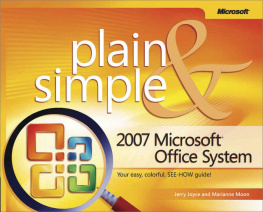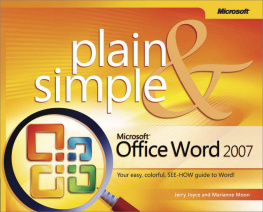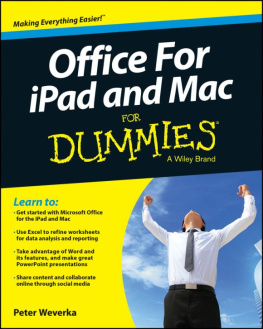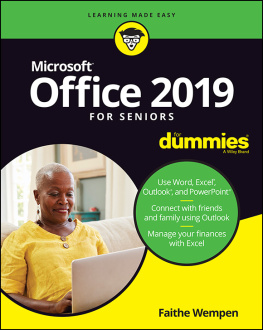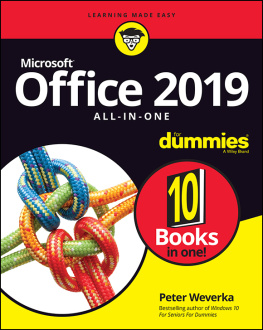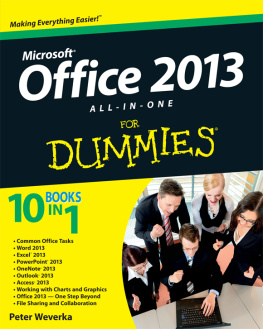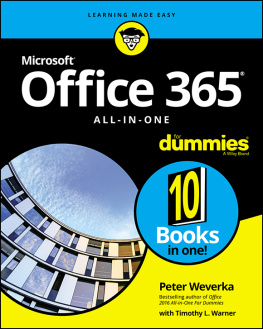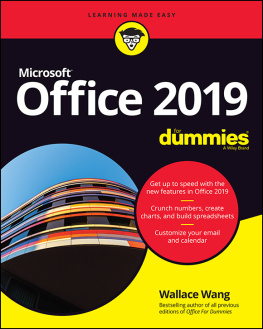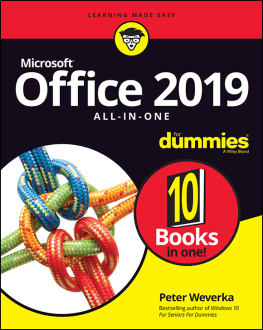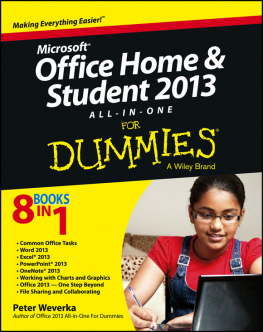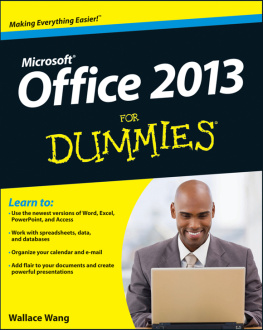Get the fast facts that make learning the 2007 Microsoft Office system plain and simple! This no-nonsense guide uses easy numbered steps and concise, straightforward language that show the most expedient ways to learn a skill or solve a problem.
Acknowledgments
This book is the result of the combined efforts of a team of skilled professionals whose work we trust and admire and whose friendship we value highly. Kari Fera and Kat Marriner, our talented typographers, proved to us once again that theyre the best in the business. They collaborated graciously on this, our 15th book, refining and producing the graphics, laying out the complex design, and wrestling with problems ranging from limited space to logical arrangement of numbered steps. We sincerely appreciate their excellent work. Our dear friend Alice Copp Smith has helped us improve every one of the books weve written. Alice does so much more than proofread and copyedit: Her gentle and witty chiding on countless yellow sticky notes makes us groan (and laugh) but teaches us to write better and, always, to get rid of those danglers! And we are fortunate indeed to be able to work with indexer par excellence Jan Wright, whose index reveals in microcosm the soul of the book. We thank this dedicated and hardworking team for their exceptional work and their unwavering good humor in the face of grueling deadlines.
We also thank Jim Boyce and Beth Sheresh for writing the Outlook sections, and Curt Frye for writing the Access section. Thanks also to the other people who worked on these three sections: Joell Smith-Borne (technical editor/copyeditor/proofreader); Kelly Henthorne (copyeditor/proofreader); Chris Pichereau (technical editor); and, especially, Debbie Berman (compositor/layout artist), who helped greatly with the coordination and integration of these sections.
At Microsoft Press we thank Lucinda Rowley and Juliana Aldous Atkinson for asking us to write this book, and we thank Kathleen Atkins for her valuable insight and helpful suggestions. Thanks also to Jim Kramer, Sandra Haynes, Victoria Thulman, Bill Teel, and Sally Stickney.
We also thank, in spirit, Oscar Tschirky, longtime matre dhtel at The Waldorf (now The Waldorf-Astoria) in New York City, whose book The Cook Book by Oscar of The Waldorf, first published in 1896, is a family heirloom and the source of the sample text in many of our screen shots.
On the home front, we thank our beautiful grandchild, Zuzu, for love, laughter, and many hours of Monopoly, at which she routinely beats both of us and winds up with more money than the bank.
Last but not least, we thank each otherfor everything.
Chapter 1. About This Book
In this section:
If you want to get the most from your computer and your software with the least amount of time and effortand who doesnt?this book is for you. Youll find 2007 Microsoft Office System Plain & Simple to be a straightforward, easy-to-read reference tool. With the premise that your computer should work for you, not you for it, this books purpose is to help you get your work done quickly and efficiently so that you can get away from the computer and live your life.
No Computerspeak!
Lets face itwhen theres a task you dont know how to do but you need to get it done in a hurry, or when youre stuck in the middle of a task and cant figure out what to do next, theres nothing more frustrating than having to read page after page of technical background material. You want the information you neednothing more, nothing lessand you want it now! And it should be easy to find and understand.
Thats what this book is about. Its written in plain English, with no technical jargon and no computerspeak. No single task in the book takes more than two pages. Just look up the task in the index or the table of contents, turn to the page, and theres the information you need, laid out in an illustrated step-by-step format. You dont get bogged down by the whys and wherefores: Just follow the steps and get your work done with a minimum of hassle. Occasionally you might have to turn to another page if the procedure youre working on is accompanied by a See Also. Thats because theres a lot of overlap among tasks, and we didnt want to keep repeating ourselves. Weve scattered some useful Tips here and there, pointed out some features that are new in this version of Office, and thrown in a Try This or a Caution once in a while. By and large, however, weve tried to remain true to the heart and soul of the book, which is that the information you need should be available to you at a glance and it should be plain and simple!
Useful Tasks...
Whether you use the programs in Microsoft Office for work, school, personal correspondence, or some of each, weve tried to pack this book with procedures for everything we could think of that you might want to do, from the simplest tasks to some of the more esoteric ones.
...And the Easiest Way to Do Them
Another thing weve tried to do in this book is to find and document the easiest way to accomplish a task. The Office programs often provide a multitude of methods for achieving a single end resultand that can be daunting or delightful, depending on the way you like to work. If you tend to stick with one favorite and familiar approach, we think the methods described in this book are the way to go. If you like trying out alternative techniques, go ahead! The intuitiveness of Microsoft Office invites exploration, and youre likely to discover ways of doing things that you think are easier or that you like better than ours. If you do, thats great! Its exactly what the developers of Office 2007 had in mind when they provided so many alternatives.
A Quick Overview
First, were assuming that Office 2007 is already installed on your computer. If it isnt, Windows makes installation so simple that you wont need our help anyway. Were also assuming that youre interested in the most popular of the Office programs: Word, Excel, PowerPoint, Outlook, Access, and Publisher. Some of the other programs that are part of the Office 2007 suiteMicrosoft OneNote, for exampleare so intuitive that youre unlikely to need any guidance; youll just jump right in and start using them. Others, such as Microsoft Project, are complex enough that youll want to find a specialized book devoted to that program.
Next, you dont have to read this book in any particular order. Its designed so that you can jump in, get the information you need, and then close the book and keep it near your computer until the next time you need it. But that doesnt mean we scattered the information about with wild abandon. Weve organized the book into some sections that deal with the individual programs in Office, and some that show you how to use the programs together. If youre new to Office or if youre stymied by the Ribbon, we recommend that you first read , for an introduction to the ways in which the programs look and work alike. Try out the step-by-step procedures that are common to most of the programs: working with the Ribbon; using dialog boxes, menus, and toolbars; saving, copying, and moving content; working with pictures and diagrams; doing some research; and getting help if you need it. Regardless of which program youre working in, youll find that the tasks you want to accomplish are always arranged in two levels. The overall type of task youre looking for is under a main heading such as Inserting a Picture or Formatting a Worksheet. Then, under each of those headings, the smaller tasks within each main task are arranged in a loose progression from the simplest to the more complex.

